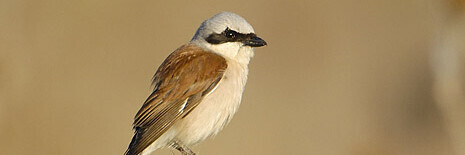Unusual form of food storage
The red-backed shrike is also sometimes known under the threatening name of "butcher" bird due to its atypical practice of storing food. It impales surplus prey such as beetles, grasshoppers and sometimes even mice in thorn bushes for later consumption.
This led to the mistaken assumption it had to impale nine bodies before it could begin eating. Besides the warm weather conditions in June and July, the red-backed shrike also need grasslands teeming with insects in order to breed.
The red-backed shrike migrates to Africa for the winter
Just like many of our other migratory birds, the red-backed shrike migrates to Africa during the winter, sometimes as far as the Eastern Cape province.
Once upon a time this migratory bird used to be a common sight here, but the destruction of its habitat has led to it becoming scarce. Fortunately, recently there seems to have been an increase in numbers, which can be explained by the warmer summers and a number of conservation measures in place.
Its numbers are particularly stable in the Krebsbachtal, where it can find plenty of hedges and shrubs as well as nutrient-poor grassland full of insects.
Whoever would like to see the red-backed shrike for themselves is more than welcome to come and explore the Krebsbachtal. Dates will be released shortly.
Get involved! Just 5€ will enable you to permanently safeguard land for our environment.
Protect land directly for our environment
Low in nutrients but rich in biodiversity: nutrient-poor grasslands
Basic data: protect biodiverse, poor grassland in the Taunus area

